These resources provide useful information for social workers addressing situations of coercive control.
Useful phone numbers
24-hour National Domestic Violence Freephone Helpline: 0808 2000 247
The Freephone 24 Hour National Domestic Violence Helpline, run in partnership between Women’s Aid and Refuge, is a national service for women experiencing domestic violence, their family, friends, colleagues and others calling on their behalf.
The Helpline can give support, help and information over the telephone, wherever the caller might be in the country. The Helpline is staffed 24 hours a day by fully trained female helpline support workers and volunteers. All calls are completely confidential. Translation facilities for callers whose first language is not English, and a service for callers who are deaf or hard of hearing are available
Men’s Advice Line: 0808 801 0327
Men’s Advice Line: confidential helpline for men experiencing domestic violence from a partner or ex-partner (or from other family members). We help by: giving you time to tell your story; offering emotional support; providing practical advice; signposting you to other services for specialist help.
Trained advisors help and advise:
- Heterosexual male victims of domestic violence
- Gay and bi male victims of domestic violence
- Frontline workers
Useful websites
- DeafHope – support for Deaf women experiencing domestic abuse
- Government guidance about Female Genital Mutilation (FGM)
- Government Guidance about Forced Marriage
- Men’s Advice Line: Advice and support for men experiencing domestic violence and abuse
- National Domestic Violence Helpline
- NICE guidelines: Domestic Violence and Abuse: Multi-agency working
- Respect: Guidance and support for working with perpetrators
- Women’s Aid: Change that Lasts
Research and guidance
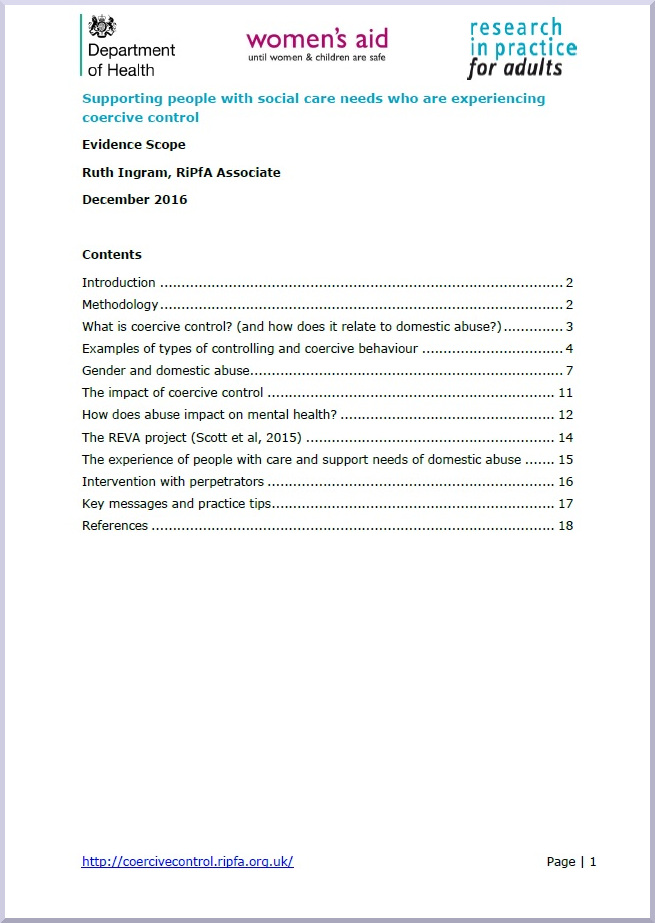 Evidence scope: coercive control
Evidence scope: coercive control
The aim of this Evidence Scope is to collate the available evidence to support social work practice with people who have care and support needs and are experiencing coercive control. It makes reference to academic literature, government policy and practice evidence, and in particular we have included the voices of survivors of domestic abuse.
This Evidence Scope is supported by a number of additional guidance sheets, which can all be found below.
 Guidance sheet one: law and policy summary
Guidance sheet one: law and policy summary
This guidance sheet gives an overview of law and policy related to coercive control in England, including sections on safeguarding adults and coercive control, mental capacity, and legal responses.
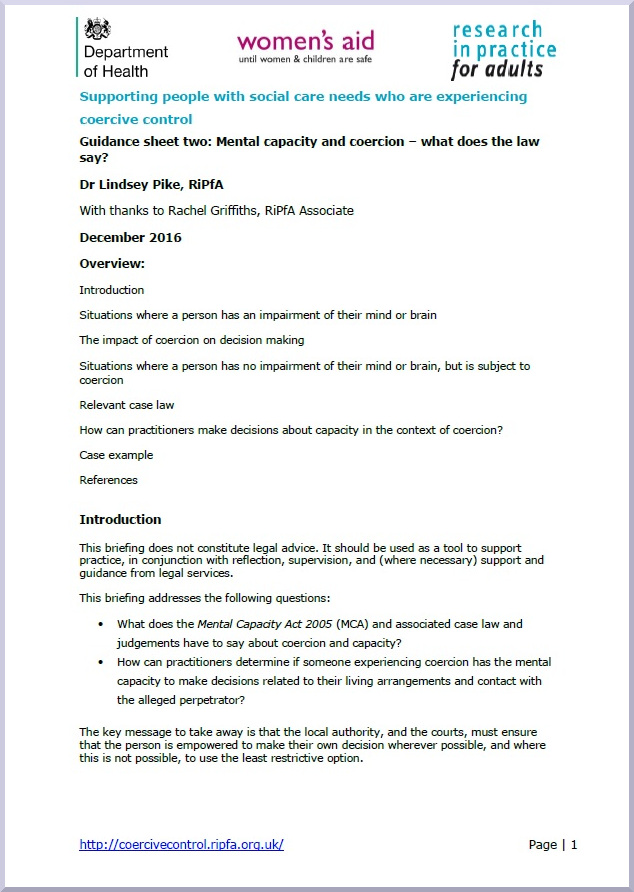 Guidance sheet two: mental capacity and coercion
Guidance sheet two: mental capacity and coercion
This briefing addresses the following questions:
- What does the Mental Capacity Act 2005 (MCA) and associated case law and judgements have to say about coercion and capacity?
- How can practitioners determine if someone experiencing coercion has the mental capacity to make decisions related to their living arrangements and contact with the alleged perpetrator?
The key message to take away is that the local authority, and the courts, must ensure that the person is empowered to make their own decision wherever possible, and where this is not possible, to use the least restrictive option.
 Guidance sheet three: what works?
Guidance sheet three: what works?
This guidance sheet looks at the evidence around work works in responding to domestic abuse and coercive control. It covers factors in the wider culture and community; Co-ordinated Community Response Model; work with individuals; supporting survivors; identification and referral; protection and victim safety; recovery; interventions with perpetrators; and finishes with a conclusion.
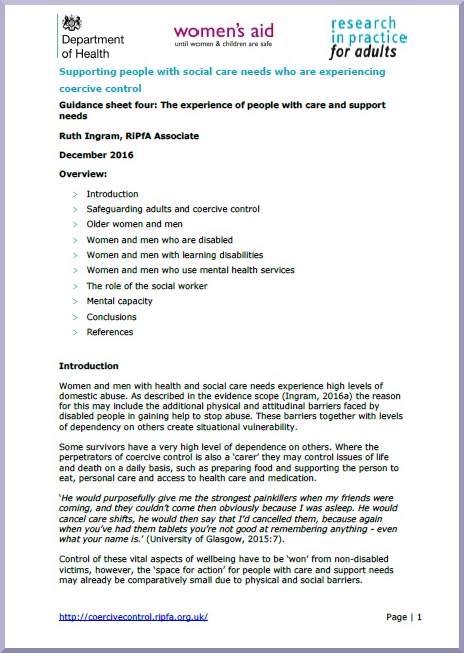 Guidance sheet four: The experience of people wih care and support needs
Guidance sheet four: The experience of people wih care and support needs
This guidance sheet outlines the evidence around the experience of coercive control and domestic abuse for people with care and support needs, and concludes by outlining the role of the social worker.
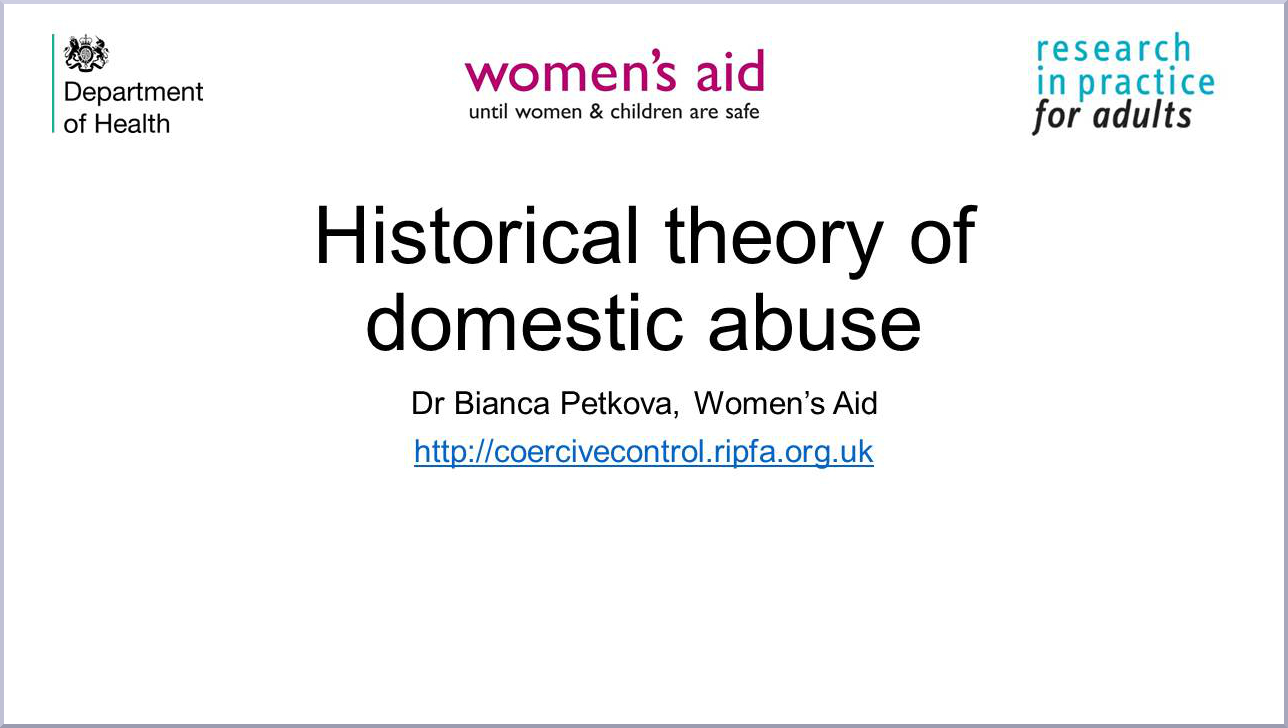 Historical theory of domestic abuse
Historical theory of domestic abuse
This powerpoint with notes outlines the development of theories about domestic abuse over time. Awareness of these theories supports good social work practice by developing a fuller understanding of perspectives on domestic abuse, and developing critical awareness of the way that theories may impact on people experiencing domestic abuse.
 Controlling or coercive behaviour in an intimate or family relationship
Controlling or coercive behaviour in an intimate or family relationship
Statutory Guidance Framework (December 2015)
This guidance provides information on:
- identifying domestic violence, domestic abuse and controlling or coercive behaviour;
- circumstances in which the new offence might apply;
- the types of evidence for the offence; the defence.
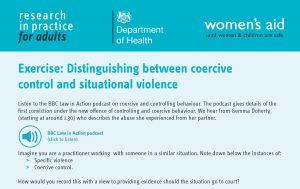 Exercise: distinguishing between coercive control and situational violence
Exercise: distinguishing between coercive control and situational violence
This exercise can be used in a training programme to support participants to distinguish between examples of coercive control and situational violence. It should be used after participants have discussed what coercive control is and the types of behaviours that it includes. It also prompts participants to consider how they would record examples of coercive control.
 JRF: Male victims of elder abuse: their experiences and needs
JRF: Male victims of elder abuse: their experiences and needs
This work explores the experiences of male victims, what support they receive and what needs go unmet. Caution is advised when interpreting the findings as the research was published in 2002; however the lack of evidence on this topic merits its inclusion.
The Framework aims to define and clarify the key capabilities (ie knowledge, attitude and values, ethical practice, skills and reflection and professional development) for working with men who use substances (drugs and alcohol) and who perpetrate intimate partner violence. It is aimed primarily at people who work within substance use treatment services, but it also relevant to those who plan and lead service developments within substance use sector including managers and commissioners.
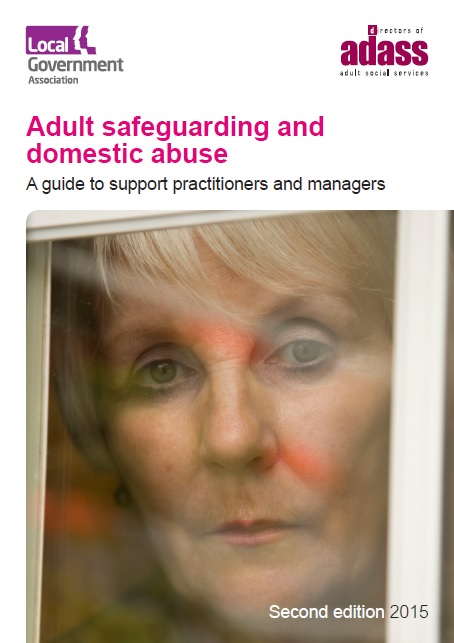 LGA and ADASS: Adult safeguarding and domestic abuse, a guide to support practitioners and managers
LGA and ADASS: Adult safeguarding and domestic abuse, a guide to support practitioners and managers
The second edition of this guidance, published in 2015, gives an overview of how safeguarding and domestic abuse interact, what the research says, and the skills and knowledge that social care practitioners need to draw upon when working in these situations.
This major research project looked into the extent to which domestic violence perpetrator programmes reduce violence and increase safety for women and children. The linked website includes a range of publications, videos and conference presentations from the project.
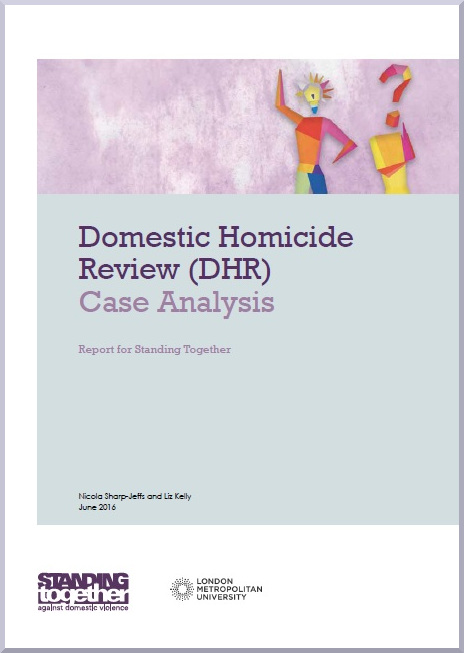 Standing Together: Domestic Homicide Review case analysis report
Standing Together: Domestic Homicide Review case analysis report
This report draws together learning from 32 DHR reports across England, and outlines key findings for practice.
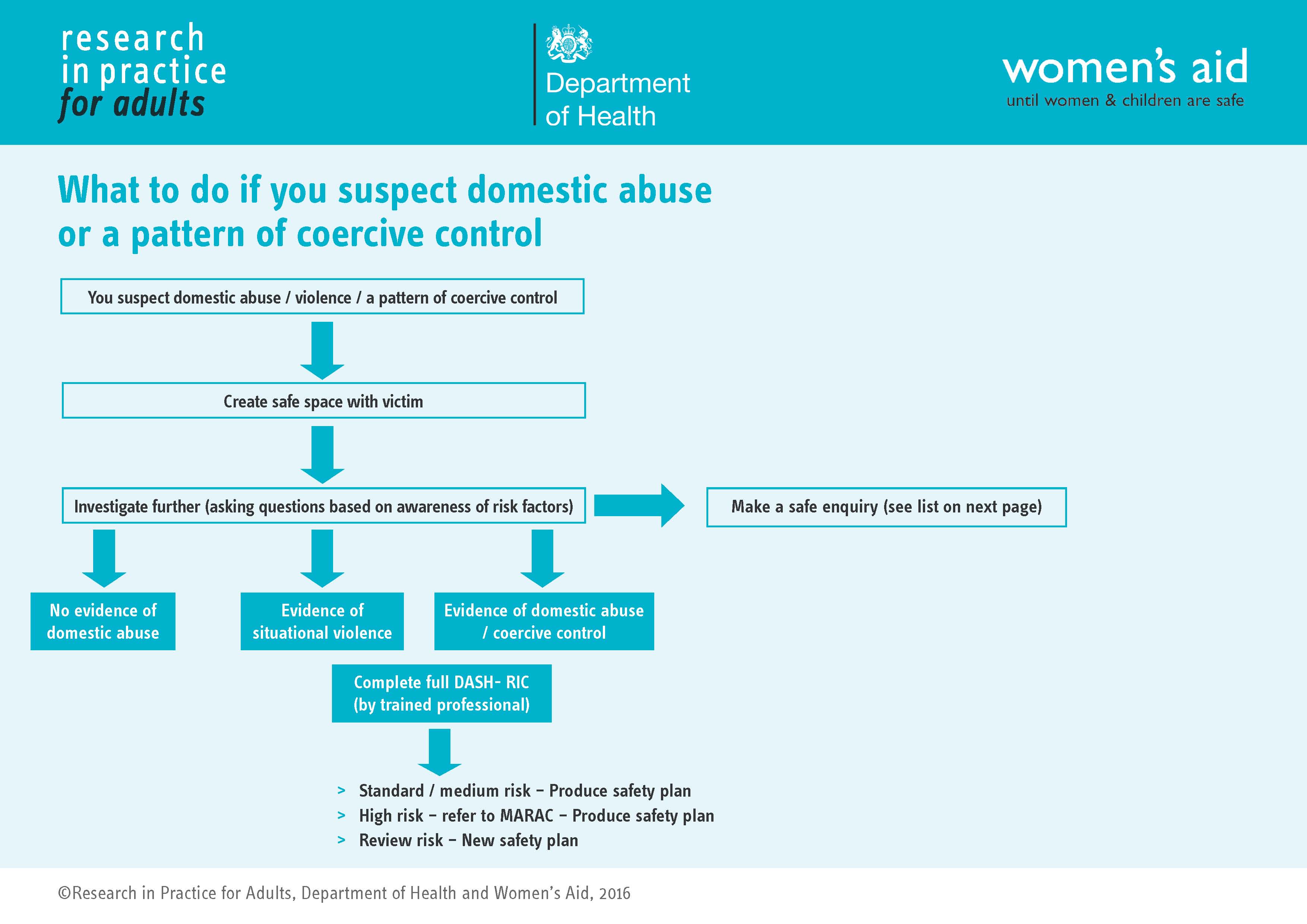 What to do if you suspect domestic abuse or a pattern of coercive control
What to do if you suspect domestic abuse or a pattern of coercive control
This resource outlines a flow chart to inform your decision making, and an outline of how to make a safe enquiry.





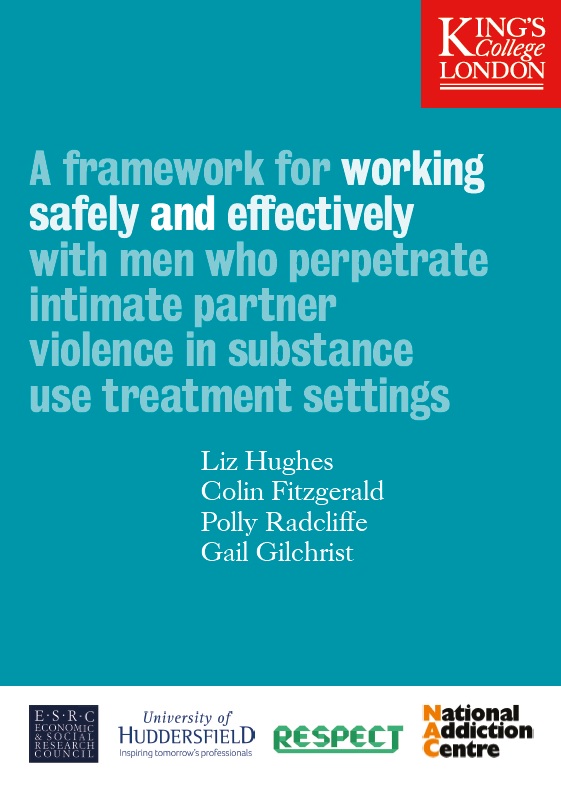 Kings College London: A framework for working safely and effectively with men who perpetrate intimate partner violence in substance use treatment settings.
Kings College London: A framework for working safely and effectively with men who perpetrate intimate partner violence in substance use treatment settings. Project Mirabal
Project Mirabal



